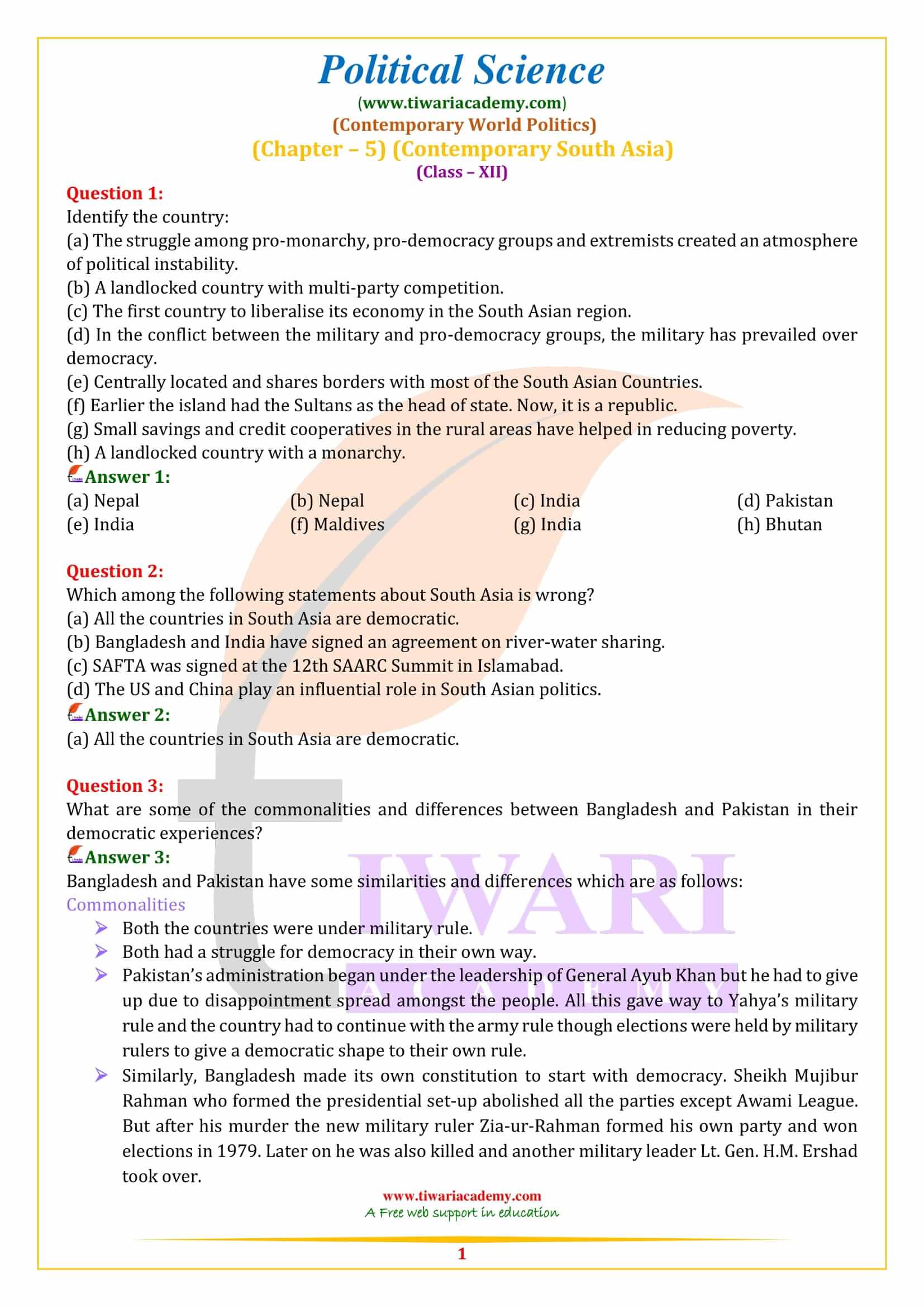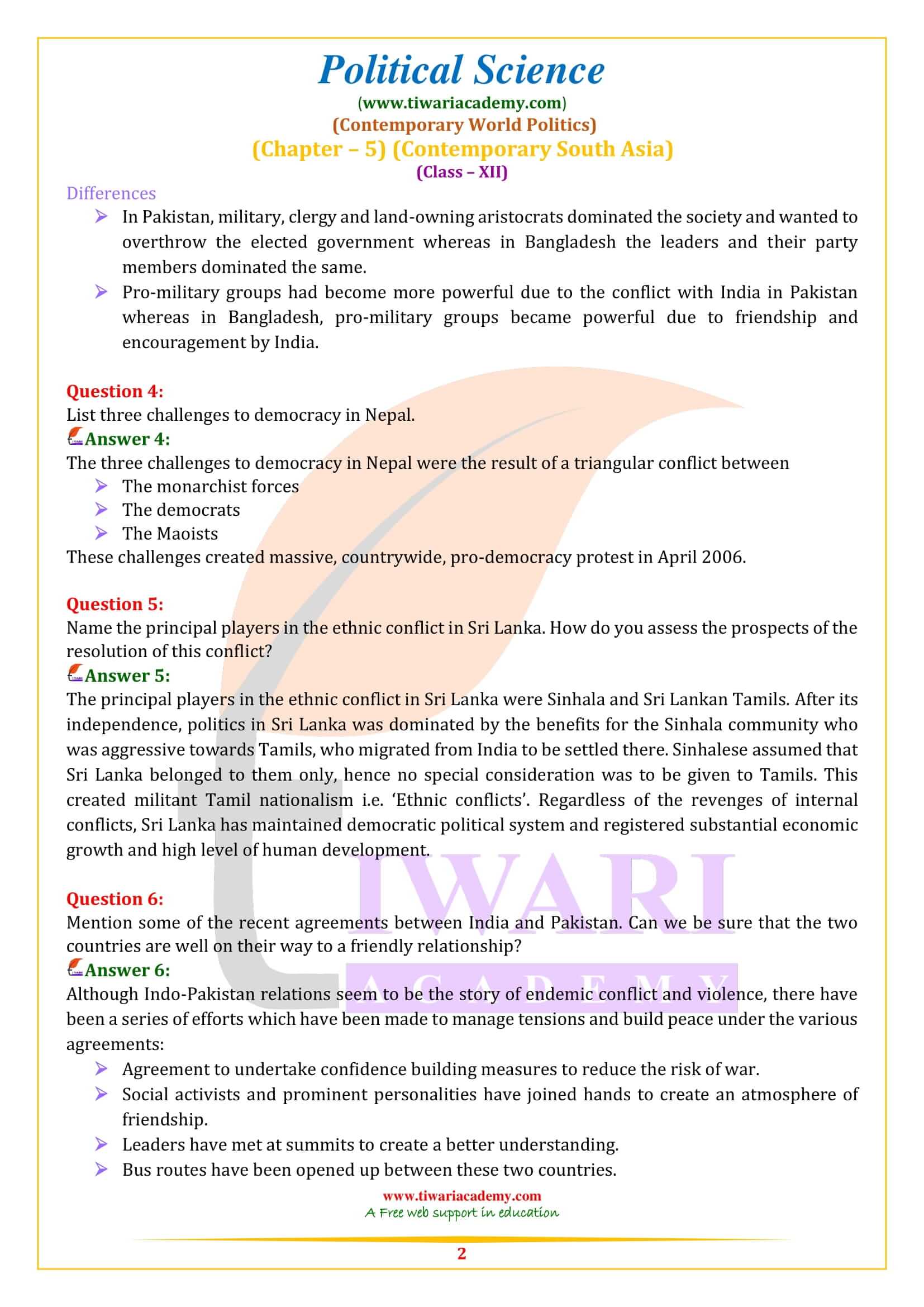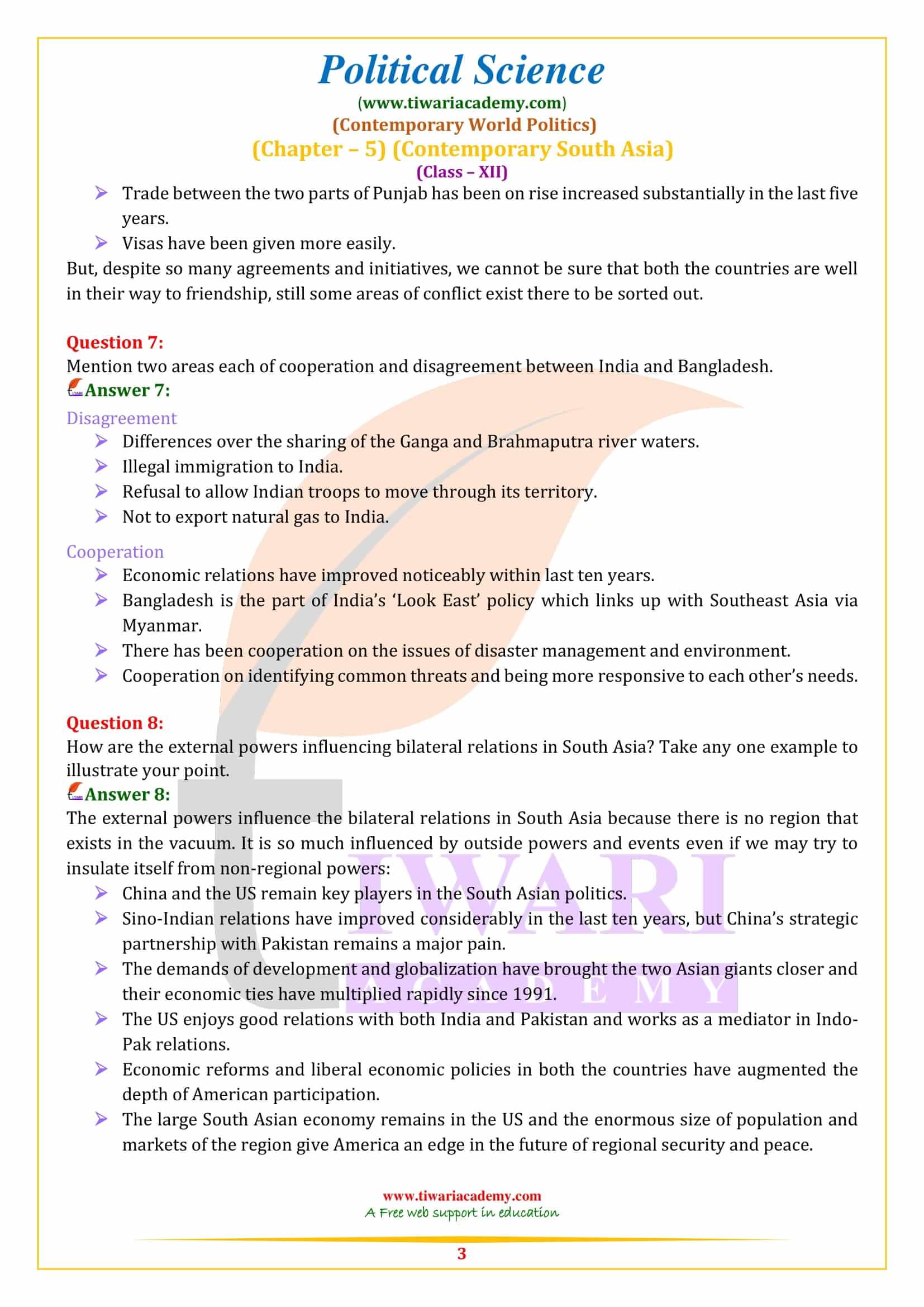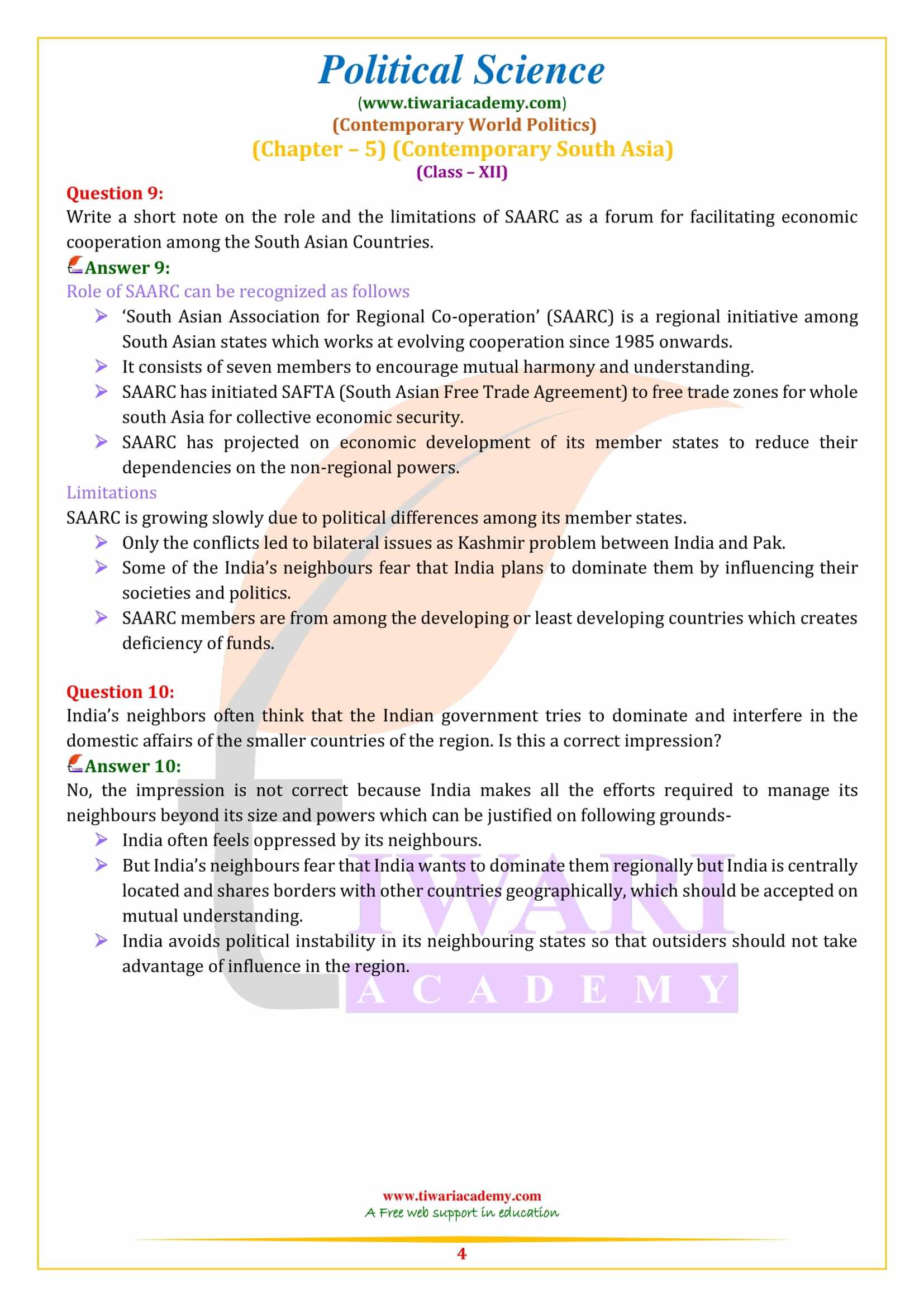NCERT Solutions for Class 12 Political Science Chapter 5 Contemporary South Asia in Hindi and English Medium updated for new Academic Session 2024-25. Class 12 Political Science Part 1 Contemporary World Politics Chapter 5 solutions are very useful for all the students whoever are studying NCERT textbooks for their exams.
NCERT Solutions for Class 12 Political Science Chapter 5
Class 12 Political Science Chapter 5 Contemporary South Asia
Class 12 Political Science Chapter 5 MCQ
Identify the country a landlocked country with multi-party competition.
Identify the country as the first country to liberalise its economy in the South Asian region.
Which among the following statements about South Asia is wrong?
What are some of the commonalities and differences between Bangladesh and Pakistan in their democratic experiences?
Bangladesh and Pakistan have some similarities and differences which are as follows:
Commonalities
- Both the countries were under military rule.
- Both had a struggle for democracy in their own way.
- Pakistan’s administration began under the leadership of General Ayub Khan but he had to give up due to disappointment spread amongst the people. All this gave way to Yahya’s military rule and the country had to continue with the army rule though elections were held by military rulers to give a democratic shape to their own rule.
- Similarly, Bangladesh made its own constitution to start with democracy. Sheikh Mujibur Rahman who formed the presidential set-up abolished all the parties except Awami League. But after his murder the new military ruler Zia-ur-Rahman formed his own party and won elections in 1979. Later on he was also killed and another military leader Lt. Gen. H.M. Ershad took over.
Differences
- In Pakistan, military, clergy and land-owning aristocrats dominated the society and wanted to overthrow the elected government whereas in Bangladesh the leaders and their party members dominated the same.
- Pro-military groups had become more powerful due to the conflict with India in Pakistan whereas in Bangladesh, pro-military groups became powerful due to friendship and encouragement by India.
List three challenges to democracy in Nepal.
The three challenges to democracy in Nepal were the result of a triangular conflict between:
- The monarchist forces
- The democrats
- The Maoists
These challenges created massive, countrywide, pro-democracy protest in April 2006.
Name the principal players in the ethnic conflict in Sri Lanka. How do you assess the prospects of the resolution of this conflict?
The principal players in the ethnic conflict in Sri Lanka were Sinhala and Sri Lankan Tamils. After its independence, politics in Sri Lanka was dominated by the benefits for the Sinhala community who was aggressive towards Tamils, who migrated from India to be settled there.
Sinhalese assumed that Sri Lanka belonged to them only, hence no special consideration was to be given to Tamils. This created militant Tamil nationalism i.e. ‘Ethnic conflicts’. Regardless of the revenges of internal conflicts, Sri Lanka has maintained democratic political system and registered substantial economic growth and high level of human development.
Mention some of the recent agreements between India and Pakistan. Can we be sure that the two countries are well on their way to a friendly relationship?
Although Indo-Pakistan relations seem to be the story of endemic conflict and violence, there have been a series of efforts which have been made to manage tensions and build peace under the various agreements:
- Agreement to undertake confidence building measures to reduce the risk of war.
- Social activists and prominent personalities have joined hands to create an atmosphere of friendship.
- Leaders have met at summits to create a better understanding.
- Bus routes have been opened up between these two countries.
- Trade between the two parts of Punjab has been on rise increased substantially in the last five years.
- Visas have been given more easily.
But, despite so many agreements and initiatives, we cannot be sure that both the countries are well in their way to friendship, still some areas of conflict exist there to be sorted out.
Mention two areas each of cooperation and disagreement between India and Bangladesh.
Disagreement
- Differences over the sharing of the Ganga and Brahmaputra river waters.
- Illegal immigration to India.
- Refusal to allow Indian troops to move through its territory.
- Not to export natural gas to India.
Cooperation
- Economic relations have improved noticeably within last ten years.
- Bangladesh is the part of India’s ‘Look East’ policy which links up with Southeast Asia via Myanmar.
- There has been cooperation on the issues of disaster management and environment.
- Cooperation on identifying common threats and being more responsive to each other’s needs.
How are the external powers influencing bilateral relations in South Asia? Take any one example to illustrate your point.
The external powers influence the bilateral relations in South Asia because there is no region that exists in the vacuum. It is so much influenced by outside powers and events even if we may try to insulate itself from non-regional powers:
- China and the US remain key players in the South Asian politics.
- Sino-Indian relations have improved considerably in the last ten years, but China’s strategic partnership with Pakistan remains a major pain.
- The demands of development and globalization have brought the two Asian giants closer and their economic ties have multiplied rapidly since 1991.
- The US enjoys good relations with both India and Pakistan and works as a mediator in Indo-Pak relations.
- Economic reforms and liberal economic policies in both the countries have augmented the depth of American participation.
- The large South Asian economy remains in the US and the enormous size of population and markets of the region give America an edge in the future of regional security and peace.
Write a short note on the role and the limitations of SAARC as a forum for facilitating economic cooperation among the South Asian Countries.
Role of SAARC can be recognized as follows:
- ‘South Asian Association for Regional Co-operation’ (SAARC) is a regional initiative among South Asian states which works at evolving cooperation since 1985 onwards.
- It consists of seven members to encourage mutual harmony and understanding.
- SAARC has initiated SAFTA (South Asian Free Trade Agreement) to free trade zones for whole south Asia for collective economic security.
- SAARC has projected on economic development of its member states to reduce their dependencies on the non-regional powers.
Limitations:
SAARC is growing slowly due to political differences among its member states.
- Only the conflicts led to bilateral issues as Kashmir problem between India and Pak.
- Some of the India’s neighbours fear that India plans to dominate them by influencing their societies and politics.
- SAARC members are from among the developing or least developing countries which creates deficiency of funds.
India’s neighbors often think that the Indian government tries to dominate and interfere in the domestic affairs of the smaller countries of the region. Is this a correct impression?
No, the impression is not correct because India makes all the efforts required to manage its neighbours beyond its size and powers which can be justified on following grounds-
- India often feels oppressed by its neighbours.
- But India’s neighbours fear that India wants to dominate them regionally but India is centrally located and shares borders with other countries geographically, which should be accepted on mutual understanding.
- India avoids political instability in its neighbouring states so that outsiders should not take advantage of influence in the region.






